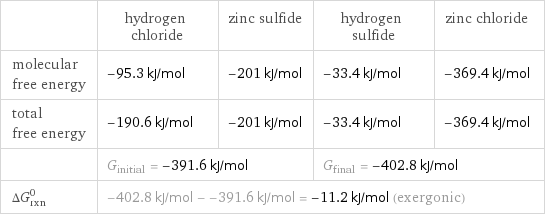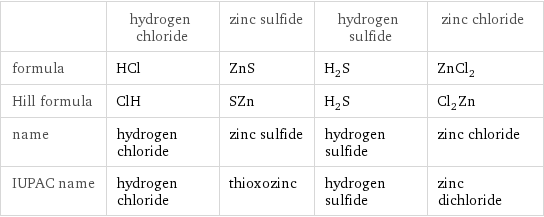Input interpretation

HCl (hydrogen chloride) + ZnS (zinc sulfide) ⟶ H_2S (hydrogen sulfide) + ZnCl_2 (zinc chloride)
Balanced equation

Balance the chemical equation algebraically: HCl + ZnS ⟶ H_2S + ZnCl_2 Add stoichiometric coefficients, c_i, to the reactants and products: c_1 HCl + c_2 ZnS ⟶ c_3 H_2S + c_4 ZnCl_2 Set the number of atoms in the reactants equal to the number of atoms in the products for Cl, H, S and Zn: Cl: | c_1 = 2 c_4 H: | c_1 = 2 c_3 S: | c_2 = c_3 Zn: | c_2 = c_4 Since the coefficients are relative quantities and underdetermined, choose a coefficient to set arbitrarily. To keep the coefficients small, the arbitrary value is ordinarily one. For instance, set c_2 = 1 and solve the system of equations for the remaining coefficients: c_1 = 2 c_2 = 1 c_3 = 1 c_4 = 1 Substitute the coefficients into the chemical reaction to obtain the balanced equation: Answer: | | 2 HCl + ZnS ⟶ H_2S + ZnCl_2
Structures

+ ⟶ +
Names

hydrogen chloride + zinc sulfide ⟶ hydrogen sulfide + zinc chloride
Reaction thermodynamics
Enthalpy

| hydrogen chloride | zinc sulfide | hydrogen sulfide | zinc chloride molecular enthalpy | -92.3 kJ/mol | -206 kJ/mol | -20.6 kJ/mol | -415.1 kJ/mol total enthalpy | -184.6 kJ/mol | -206 kJ/mol | -20.6 kJ/mol | -415.1 kJ/mol | H_initial = -390.6 kJ/mol | | H_final = -435.7 kJ/mol | ΔH_rxn^0 | -435.7 kJ/mol - -390.6 kJ/mol = -45.1 kJ/mol (exothermic) | | |
Gibbs free energy

| hydrogen chloride | zinc sulfide | hydrogen sulfide | zinc chloride molecular free energy | -95.3 kJ/mol | -201 kJ/mol | -33.4 kJ/mol | -369.4 kJ/mol total free energy | -190.6 kJ/mol | -201 kJ/mol | -33.4 kJ/mol | -369.4 kJ/mol | G_initial = -391.6 kJ/mol | | G_final = -402.8 kJ/mol | ΔG_rxn^0 | -402.8 kJ/mol - -391.6 kJ/mol = -11.2 kJ/mol (exergonic) | | |
Equilibrium constant
![Construct the equilibrium constant, K, expression for: HCl + ZnS ⟶ H_2S + ZnCl_2 Plan: • Balance the chemical equation. • Determine the stoichiometric numbers. • Assemble the activity expression for each chemical species. • Use the activity expressions to build the equilibrium constant expression. Write the balanced chemical equation: 2 HCl + ZnS ⟶ H_2S + ZnCl_2 Assign stoichiometric numbers, ν_i, using the stoichiometric coefficients, c_i, from the balanced chemical equation in the following manner: ν_i = -c_i for reactants and ν_i = c_i for products: chemical species | c_i | ν_i HCl | 2 | -2 ZnS | 1 | -1 H_2S | 1 | 1 ZnCl_2 | 1 | 1 Assemble the activity expressions accounting for the state of matter and ν_i: chemical species | c_i | ν_i | activity expression HCl | 2 | -2 | ([HCl])^(-2) ZnS | 1 | -1 | ([ZnS])^(-1) H_2S | 1 | 1 | [H2S] ZnCl_2 | 1 | 1 | [ZnCl2] The equilibrium constant symbol in the concentration basis is: K_c Mulitply the activity expressions to arrive at the K_c expression: Answer: | | K_c = ([HCl])^(-2) ([ZnS])^(-1) [H2S] [ZnCl2] = ([H2S] [ZnCl2])/(([HCl])^2 [ZnS])](../image_source/9c932327b6f4ea7b0f0ead53abc7619f.png)
Construct the equilibrium constant, K, expression for: HCl + ZnS ⟶ H_2S + ZnCl_2 Plan: • Balance the chemical equation. • Determine the stoichiometric numbers. • Assemble the activity expression for each chemical species. • Use the activity expressions to build the equilibrium constant expression. Write the balanced chemical equation: 2 HCl + ZnS ⟶ H_2S + ZnCl_2 Assign stoichiometric numbers, ν_i, using the stoichiometric coefficients, c_i, from the balanced chemical equation in the following manner: ν_i = -c_i for reactants and ν_i = c_i for products: chemical species | c_i | ν_i HCl | 2 | -2 ZnS | 1 | -1 H_2S | 1 | 1 ZnCl_2 | 1 | 1 Assemble the activity expressions accounting for the state of matter and ν_i: chemical species | c_i | ν_i | activity expression HCl | 2 | -2 | ([HCl])^(-2) ZnS | 1 | -1 | ([ZnS])^(-1) H_2S | 1 | 1 | [H2S] ZnCl_2 | 1 | 1 | [ZnCl2] The equilibrium constant symbol in the concentration basis is: K_c Mulitply the activity expressions to arrive at the K_c expression: Answer: | | K_c = ([HCl])^(-2) ([ZnS])^(-1) [H2S] [ZnCl2] = ([H2S] [ZnCl2])/(([HCl])^2 [ZnS])
Rate of reaction
![Construct the rate of reaction expression for: HCl + ZnS ⟶ H_2S + ZnCl_2 Plan: • Balance the chemical equation. • Determine the stoichiometric numbers. • Assemble the rate term for each chemical species. • Write the rate of reaction expression. Write the balanced chemical equation: 2 HCl + ZnS ⟶ H_2S + ZnCl_2 Assign stoichiometric numbers, ν_i, using the stoichiometric coefficients, c_i, from the balanced chemical equation in the following manner: ν_i = -c_i for reactants and ν_i = c_i for products: chemical species | c_i | ν_i HCl | 2 | -2 ZnS | 1 | -1 H_2S | 1 | 1 ZnCl_2 | 1 | 1 The rate term for each chemical species, B_i, is 1/ν_i(Δ[B_i])/(Δt) where [B_i] is the amount concentration and t is time: chemical species | c_i | ν_i | rate term HCl | 2 | -2 | -1/2 (Δ[HCl])/(Δt) ZnS | 1 | -1 | -(Δ[ZnS])/(Δt) H_2S | 1 | 1 | (Δ[H2S])/(Δt) ZnCl_2 | 1 | 1 | (Δ[ZnCl2])/(Δt) (for infinitesimal rate of change, replace Δ with d) Set the rate terms equal to each other to arrive at the rate expression: Answer: | | rate = -1/2 (Δ[HCl])/(Δt) = -(Δ[ZnS])/(Δt) = (Δ[H2S])/(Δt) = (Δ[ZnCl2])/(Δt) (assuming constant volume and no accumulation of intermediates or side products)](../image_source/2621dd20a49f118acd3be90dfc26fec1.png)
Construct the rate of reaction expression for: HCl + ZnS ⟶ H_2S + ZnCl_2 Plan: • Balance the chemical equation. • Determine the stoichiometric numbers. • Assemble the rate term for each chemical species. • Write the rate of reaction expression. Write the balanced chemical equation: 2 HCl + ZnS ⟶ H_2S + ZnCl_2 Assign stoichiometric numbers, ν_i, using the stoichiometric coefficients, c_i, from the balanced chemical equation in the following manner: ν_i = -c_i for reactants and ν_i = c_i for products: chemical species | c_i | ν_i HCl | 2 | -2 ZnS | 1 | -1 H_2S | 1 | 1 ZnCl_2 | 1 | 1 The rate term for each chemical species, B_i, is 1/ν_i(Δ[B_i])/(Δt) where [B_i] is the amount concentration and t is time: chemical species | c_i | ν_i | rate term HCl | 2 | -2 | -1/2 (Δ[HCl])/(Δt) ZnS | 1 | -1 | -(Δ[ZnS])/(Δt) H_2S | 1 | 1 | (Δ[H2S])/(Δt) ZnCl_2 | 1 | 1 | (Δ[ZnCl2])/(Δt) (for infinitesimal rate of change, replace Δ with d) Set the rate terms equal to each other to arrive at the rate expression: Answer: | | rate = -1/2 (Δ[HCl])/(Δt) = -(Δ[ZnS])/(Δt) = (Δ[H2S])/(Δt) = (Δ[ZnCl2])/(Δt) (assuming constant volume and no accumulation of intermediates or side products)
Chemical names and formulas

| hydrogen chloride | zinc sulfide | hydrogen sulfide | zinc chloride formula | HCl | ZnS | H_2S | ZnCl_2 Hill formula | ClH | SZn | H_2S | Cl_2Zn name | hydrogen chloride | zinc sulfide | hydrogen sulfide | zinc chloride IUPAC name | hydrogen chloride | thioxozinc | hydrogen sulfide | zinc dichloride
Substance properties

| hydrogen chloride | zinc sulfide | hydrogen sulfide | zinc chloride molar mass | 36.46 g/mol | 97.44 g/mol | 34.08 g/mol | 136.3 g/mol phase | gas (at STP) | solid (at STP) | gas (at STP) | solid (at STP) melting point | -114.17 °C | 1064 °C | -85 °C | 293 °C boiling point | -85 °C | | -60 °C | density | 0.00149 g/cm^3 (at 25 °C) | 4.1 g/cm^3 | 0.001393 g/cm^3 (at 25 °C) | solubility in water | miscible | | | soluble dynamic viscosity | | | 1.239×10^-5 Pa s (at 25 °C) | odor | | | | odorless
Units
